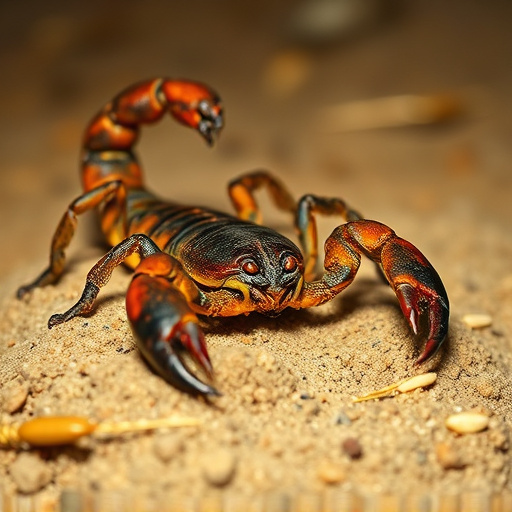Scorpion stings pose significant health risks, with symptoms varying by species and individual sensitivity. Effective scorpion control involves immediate first aid (washing, cold compresses), managing severe reactions with medical attention, and proactive prevention measures (cleaning, inspecting, sealing). While home treatments can alleviate minor symptoms, they shouldn't replace professional care for proper scorpion control and complication avoidance.
Scorpion stings can range from harmless to life-threatening, making it crucial to understand these encounters. This guide offers a comprehensive approach to managing scorpion stings safely and effectively. We explore symptoms, risk factors, immediate actions, first aid, and when to seek medical attention. Learn about prevention strategies, natural remedies, and home treatments for relief. Equip yourself with these essential guidelines for effective scorpion control and peace of mind.
- Understanding Scorpion Stings: Identifying Symptoms and Risk Factors
- Immediate Actions: What to Do When Stinged by a Scorpion
- First Aid Measures for Scorpion Stings: Soothing the Pain and Reducing Inflammation
- Medical Attention: When to Seek Help and Available Treatment Options
- Preventing Scorpion Bites: Safety Measures Around Their Habitat
- Natural Remedies and Home Treatments for Scorpion Sting Relief
Understanding Scorpion Stings: Identifying Symptoms and Risk Factors

Scorpion stings can be a serious matter, especially for those living in or visiting regions where scorpions are prevalent. Understanding these stings is key to effective treatment and scorpion control. When a scorpion stings, it injects venom through its tail, which can cause a range of symptoms from mild to severe. Identifying these symptoms early is crucial. Common signs include intense local pain at the site of the sting, rapid onset of swelling, and in some cases, visible fang marks.
Risk factors vary depending on the species of scorpion and individual sensitivity. Certain scorpions have more potent venoms than others. People with pre-existing medical conditions like allergies or asthma are at higher risk for severe reactions. Additionally, children and the elderly might experience more intense symptoms. Recognizing these risk factors can help in prompt action and better management of scorpion stings, facilitating effective scorpion control measures.
Immediate Actions: What to Do When Stinged by a Scorpion

When stung by a scorpion, immediate and proper action is crucial for effective treatment and minimizing pain and potential complications. The first step is to remain calm; panicking can lead to poor decision-making. Slowly remove any clothing or jewelry near the sting site to facilitate cleaning and reduce irritation.
Washing the affected area with soap and warm water is essential to disinfect the wound and prevent bacterial infections. Applying a cold compress or ice pack wrapped in a thin cloth can help reduce swelling and numb the pain. It’s important to remember not to use direct ice, as this can cause further tissue damage. For severe pain or significant swelling, over-the-counter pain relievers like ibuprofen or acetaminophen can be taken, but always consult a healthcare professional for guidance on dosage.
First Aid Measures for Scorpion Stings: Soothing the Pain and Reducing Inflammation

In the event of a scorpion sting, prompt first aid measures can significantly alleviate pain and reduce inflammation. The initial step is to wash the affected area with mild soap and water to minimize the risk of infection. Applying a cold compress or ice pack wrapped in a thin cloth can help numb the pain and reduce swelling. It’s crucial to avoid scratching or rubbing the sting site, as this may introduce bacteria and worsen the reaction.
Over-the-counter pain relievers like ibuprofen or acetaminophen can be taken to manage discomfort. In cases of severe reactions or if symptoms persist, seeking medical attention is essential. Remember, effective scorpion control involves not just managing stings but also preventing them through awareness and safety measures in environments where scorpions are prevalent.
Medical Attention: When to Seek Help and Available Treatment Options

In the event of a scorpion sting, determining when to seek medical attention is crucial for effective scorpion control and managing symptoms. While most stings may be treated at home with over-the-counter medications, certain situations warrant immediate professional assistance. Severe allergic reactions, such as difficulty breathing, swelling in the face or throat, or rapid heartbeat, require urgent care. Additionally, if the sting is located near sensitive areas like the eyes, mouth, or genitals, or if there are signs of infection (redness, warmth, pus), it’s essential to consult a healthcare provider promptly.
Treatment options for scorpion stings vary based on the species and severity. For minor cases, applying ice packs, elevating the affected area, and taking oral antihistamines or pain relievers can help alleviate itching and discomfort. In more severe instances, medical professionals may administer anti-venom injections to neutralize the venom’s effects. Additionally, they might prescribe topical creams or antibiotics if an infection is suspected. Remember, prompt recognition of symptoms and seeking appropriate scorpion control measures are vital for a successful recovery.
Preventing Scorpion Bites: Safety Measures Around Their Habitat

Scorpion stings can be painful and, in some cases, dangerous, but taking preventive measures around their habitat is key to avoiding bites. Understanding where scorpions live and what attracts them is crucial for scorpion control. These arachnids often seek shelter in dark, tight spaces like cracks, crevices, and under debris. They are also drawn to areas with abundant food sources, such as insects and other small creatures. To minimize the risk of encounters, keep your living space clean and free of clutter, especially in areas where scorpions are known to inhabit.
Regularly inspect your surroundings for potential hiding spots and seal any gaps or openings that might allow scorpions inside. Using proper scorpion control methods, like setting traps or applying safe, non-toxic repellents, can also help deter them from your space. Additionally, maintaining good lighting in outdoor areas discourages scorpions from lurking, as they prefer darkness. By taking these proactive steps, you significantly reduce the chances of a scorpion sting and ensure a safer environment for yourself and your family.
Natural Remedies and Home Treatments for Scorpion Sting Relief

When dealing with a scorpion sting, many people turn to natural remedies and home treatments for relief. While professional medical attention is crucial for severe reactions or children/elderly patients, certain at-home measures can help alleviate pain and itching. Applying cold compresses to the affected area can reduce swelling and numb the pain. Additionally, over-the-counter antihistamines or hydrocortisone creams may be used to combat itching and inflammation.
Some natural remedies include using aloe vera gel for its soothing properties, applying apple cider vinegar to neutralize the venom’s effects, or trying a paste made from baking soda and water to draw out the poison. It’s important to remember that these home treatments can provide symptom relief but may not address the underlying issue. For effective scorpion control and management of stings, consulting a healthcare professional is essential to ensure proper care and prevent potential complications.
In conclusion, understanding scorpion stings is key to effective scorpion control. By recognizing symptoms, knowing immediate actions to take, and implementing proper first aid measures, you can significantly reduce pain and inflammation. While some cases may require medical attention, taking preventive measures around their habitat and using natural remedies can further minimize the risk of severe scorpion bites. Remember, being prepared and informed is essential for both treating stings safely and maintaining a secure environment.
